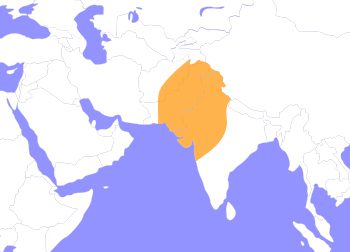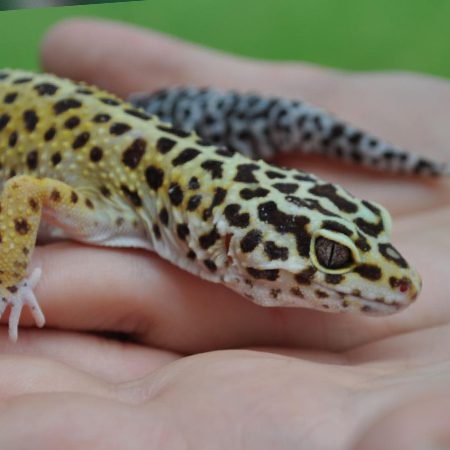Leopard Gecko
Eublepharis macularius
The standard colorings of Leopard Gecko are a yellow body with black spots all over their back and arms. Their underside is a white or pink color and their tail will have a purple or blue hue. As they are very popular pets for their calm and friendly nature, many more colors have been bred for them. They can be white, albino, orange, and brown in many different patterns. They have thick, segmented tails that can be lost and regrown. These tails are designed to mimic the gecko’s head so a predator may mistakenly attack the tail instead. The gecko can then drop their tail and run away before the predator realizes what happened. They have clawed toes to climb rocks and trees. Their skin is very bumpy but soft to touch.
With their tail, these geckos usually grow to be about 8 in long and weigh about 2 oz. Males tend to be larger than females. In captivity, leopard geckos will live over 20 years. Their diet can change easily, depending on what is available, even being known to eat scorpions, spiders, and centipedes. They are also known as tail rattlers, like rattlesnakes, but Leopard Geckos do it when they are excited rather than threatened.

Leopard Geckos inhabit dry grassland and desert regions of Afghanistan, Pakistan, and some parts of India and Iran.
HABITAT -They can be found in arid and semi-arid deserts throughout Afghanistan, Iraq, Iran, Pakistan, and India.
DIET -They will mainly eat insects but adapt their diet to what is available.
FUN FACT -Unlike most other geckos, Leopard geckos have moveable eyelids.
SOCIAL BEHAVIOR -They are very docile and friendly, only males shouldn’t be around each other.
ACTIVITY -They are nocturnal and hide under rocks or in burrows during the day.
PREDATORS -Their predators tend to be snakes, foxes, and other large predators.
SIZE -They average at about 8 in long and weigh around 2 oz.
RELATIVES -They are in the same family as the Fat-tailed and Banded geckos.
CONSERVATION -They are not evaluated by the IUCN.
Cub Creek Animal Care Information
Housing - We have two enclosures of leopard geckos that both live in appropriately sized terrariums. They are both supplied with plenty of hides to explore as well as a shed box that contains sphagnum moss that is kept wet to simulate high humidity and make shedding a breeze.
Diet - Our lizards are fed on a reptile specific schedule, meaning they are fed Monday, Tuesday, Thursday, and Saturday. Reptiles have slow metabolisms and do not require to be fed everyday if they are fed adequately. We feed our leopard geckos live insects; mainly, they get mealworms but sometimes are also fed crickets (which they love to chase).
Enrichment - Reptiles do not need a lot of enrichment beyond their various hides. Our campers give them plenty of stimulation by handling them and even occasionally bringing them outside on warmer days in the summer.


